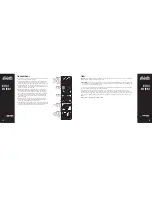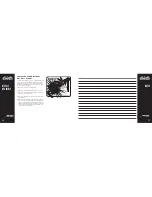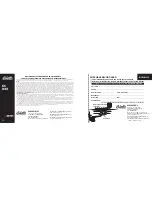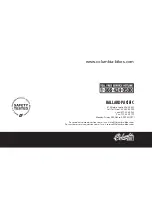
48
49
BICYCLE
ASSEMBLY
BICYCLE
ASSEMBLY
INSPECTION OF BEARINGS
Maintenance:
Frequently check the bearings of the bicycle. Have a bicycle service shop lubricate the bearings
once a year or any time they do not pass the following tests.
Head Tube Bearings:
The fork should turn freely and smoothly at all times. With the front wheel off the ground,
you should not be able to move the fork up, down, or side-to-side in the head tube.
Crank Bearings:
The crank should turn freely and smoothly at all times and the front sprockets should not be loose
on the crank. You should not be able to move the pedal end of the crank from side-to-side.
Wheel Bearings:
Lift each end of the bicycle off the ground and slowly spin the raised wheel by hand. The
bearings are correctly adjusted if:
The wheel spins freely and easily. The weight of the spoke relector, when you put it toward the front or rear of the
bicycle, causes the wheel to spin back and forth several times. There is no side-to-side movement at the wheel rim
when you push it to the side with light force.
LUBRICATION / MAINTENANCE
WARNING:
Do not over lubricate. If oil gets on the wheel rims or the brake shoes, it will reduce brake
performance and a longer distance to stop the bicycle will be necessary. Injury to the rider or to others can occur.
The chain can throw excess oil onto the wheel rim. Wipe excess oil off the chain.
Keep all oil off the surfaces of the pedals where your feet rest.
Using soap and hot water, wash all oil off the wheel rims, the brake shoes, the pedals, and the tires. Rinse
with clean water and dry completely before you ride the bicycle.
REPAIR AND SERVICE
WARNING:
Inspect the bicycle frequently. Failure to inspect the bicycle and to make repairs or adjustments,
as necessary can result in injury to the rider or to others. Make sure all parts are correctly assembled and
adjusted as written in this manual and any “Special Instructions.”
Immediately replace any damaged, missing, or badly worn parts.
Make sure all fasteners are correctly tightened as written in this manual and any “Special Instructions.” Parts
that are not tight enough can be lost or operate poorly. Overtightened parts can be damaged. Make sure any
replacement fasteners are the correct size and type.
If your frame is aluminum, inspect the bicycle frame carefully and frequently. Aluminum frames can develop
very small cracks due to stress, severe shocks, etc. If you see any small cracks, stop riding the bicycle. Have
the frame inspected by a qualiied professional at a bicycle service shop before riding the bicycle again.
NOTE:
Have a bicycle service shop make any repairs or adjustments for which you do not have the correct
tools or if the instructions in this manual or any “Special Instructions” are not suficient for you.
REAR WHEEL/CHAIN ADJUSTMENT
Maintenance: The chain must be at the correct tightness. If too tight, the bicycle will be dificult to pedal. If too
loose, the chain can come off the sprockets.
WARNING:
The chain must remain on
the sprockets. If the chain comes off the
sprockets, the bike will not operate.
When the chain (1) is at the correct
tightness, you can pull it one-half inch (2)
away from a straightedge (3) as shown.
1
2
3
1
3
2




















